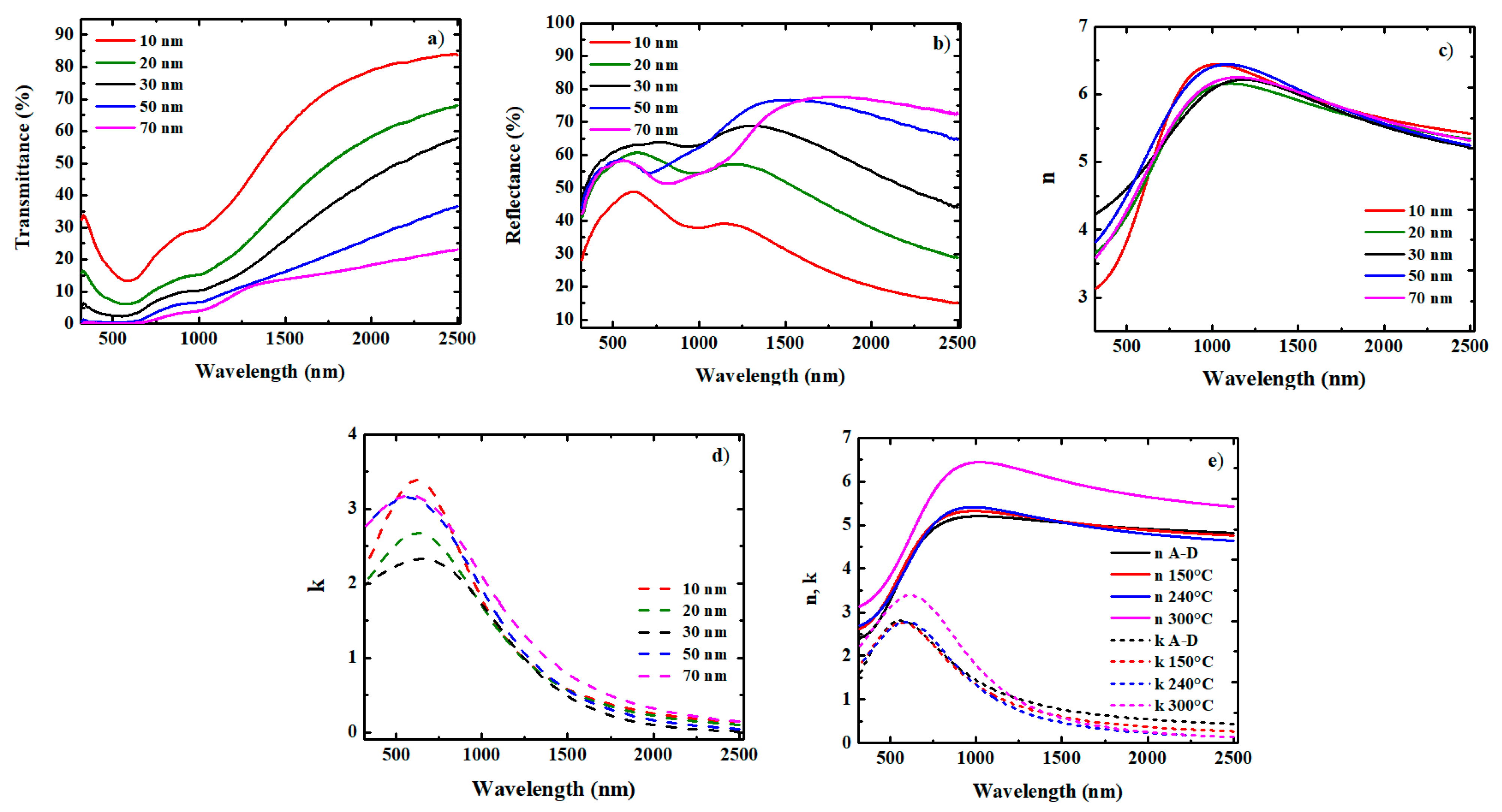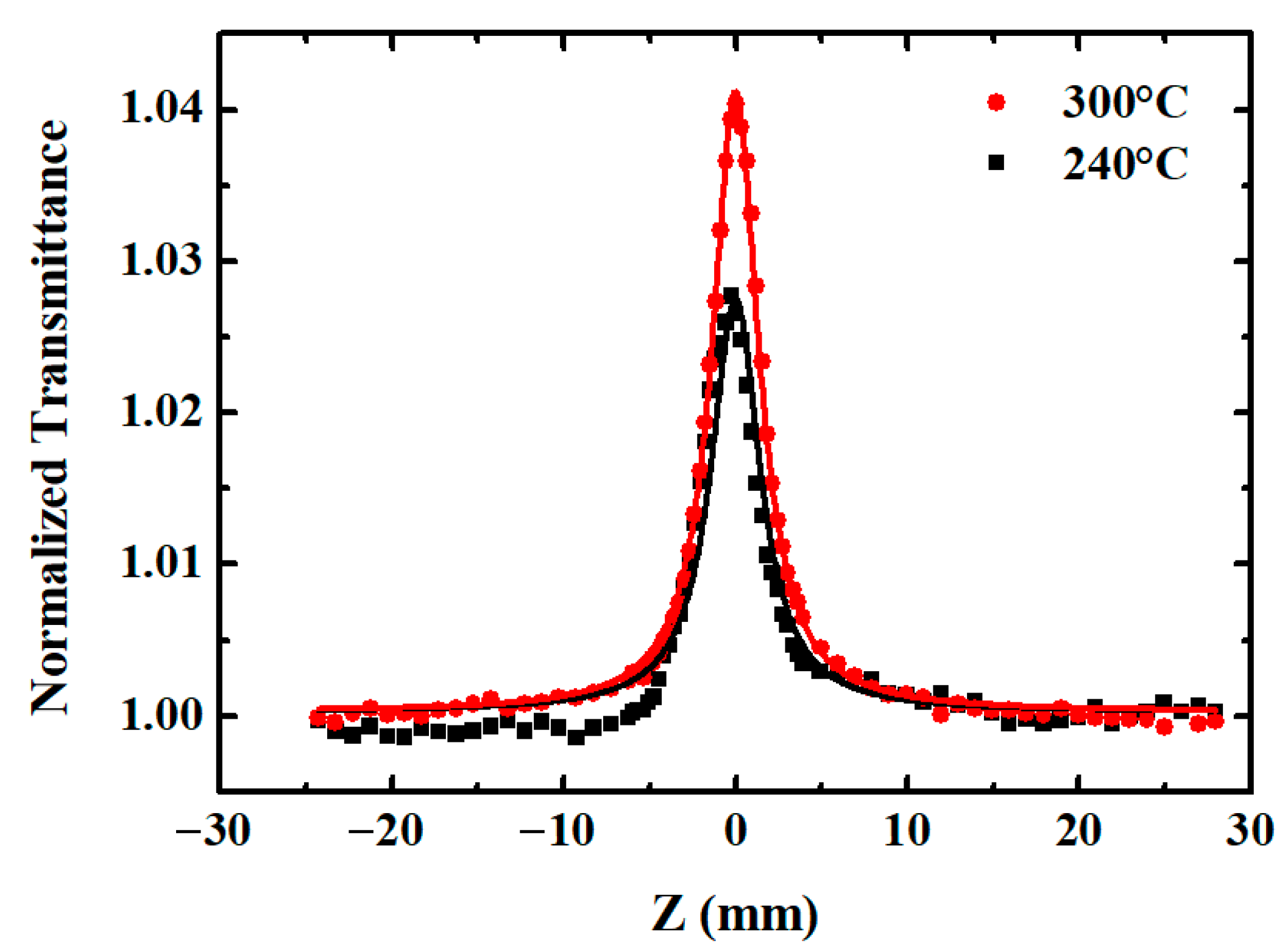Optimization of the Saturable Absorption of 2D Bi2Te3 Layers
Abstract
1. Introduction
2. Materials and Characterizations
2.1. Thin-Film Deposition and Annealing
2.2. UV-Vis Spectrophotometry
2.3. Structural Characterization of Bi2Te3 Thin Films
3. Nonlinear Optical Studies and Discussion
4. Conclusions
Author Contributions
Funding
Data Availability Statement
Conflicts of Interest
References
- Liu, W.; Liu, M.; Liu, X.; Wang, X.; Deng, H.; Lei, M.; Wei, Z.; Wei, Z. Recent Advances of 2D Materials in Nonlinear Photonics and Fiber Lasers. Adv. Opt. Mater. 2020, 8, 1901631. [Google Scholar] [CrossRef]
- Zhai, X.-P.; Ma, B.; Wang, Q.; Zhang, H.-L. 2D materials towards ultrafast photonic applications. Phys. Chem. Chem. Phys. 2020, 22, 22140–22156. [Google Scholar] [CrossRef] [PubMed]
- Xie, Z.; Zhao, T.; Yu, X.; Wang, J. Nonlinear Optical Properties of 2D Materials and their Applications. Small 2024, 20, 2311621. [Google Scholar] [CrossRef]
- Zhang, H.; Liu, C.-X.; Qi, X.-L.; Dai, X.; Fang, Z.; Zhang, S.-C. Topological insulators in Bi2Se3, Bi2Te3 and Sb2Te3 with a single Dirac cone on the surface. Nat. Phys. 2009, 5, 438–442. [Google Scholar] [CrossRef]
- Kim, V.V.; Bundulis, A.; Popov, V.S.; Lavrentyev, N.A.; Lizunova, A.A.; Shuklov, I.A.; Ponomarenko, V.P.; Grube, J.; Ganeev, R.A. Third-order optical nonlinearities of exfoliated Bi2Te3 nanoparticle films in UV, visible and near-infrared ranges measured by tunable femtosecond pulses. Opt. Express 2022, 30, 6970. [Google Scholar] [CrossRef]
- Verrone, R.-N.; Moisset, C.; Lemarchand, F.; Campos, A.; Cabié, M.; Perrin-Pellegrino, C.; Lumeau, J.; Natoli, J.-Y.; Iliopoulos, K. Thickness-Dependent Optical Nonlinearities of Nanometer-Thick Sb2Te3 Thin Films: Implications for Mode-Locking and Super-resolved Direct Laser Writing. ACS Appl. Nano Mater. 2020, 3, 7963–7972. [Google Scholar] [CrossRef]
- Xing, X.; Liu, Y.; Han, J.; Liu, W.; Wei, Z. Preparation of High Damage Threshold Device Based on Bi2Se3 Film and Its Application in Fiber Lasers. ACS Photonics 2023, 10, 2264–2271. [Google Scholar] [CrossRef]
- Kowalczyk, M.; Bogusławski, J.; Zybała, R.; Mars, K.; Mikuła, A.; Soboń, G.; Sotor, J. Sb2Te3-deposited D-shaped fiber as a saturable absorber for mode-locked Yb-doped fiber lasers. Opt. Mater. Express 2016, 6, 2273. [Google Scholar] [CrossRef]
- Boguslawski, J.; Sotor, J.; Sobon, G.; Tarka, J.; Jagiello, J.; Macherzynski, W.; Lipinska, L.; Abramski, K.M. Mode-locked Er-doped fiber laser based on liquid phase exfoliated Sb2Te3 topological insulator. Laser Phys. 2014, 24, 105111. [Google Scholar] [CrossRef]
- Liu, H.; Zheng, X.-W.; Liu, M.; Zhao, N.; Luo, A.-P.; Luo, Z.-C.; Xu, W.-C.; Zhang, H.; Zhao, C.-J.; Wen, S.-C. Femtosecond pulse generation from a topological insulator mode-locked fiber laser. Opt. Express 2014, 22, 6868. [Google Scholar] [CrossRef]
- Mu, H.; Wang, Z.; Yuan, J.; Xiao, S.; Chen, C.; Chen, Y.; Chen, Y.; Song, J.; Wang, Y.; Xue, Y.; et al. Graphene–Bi2Te3 Heterostructure as Saturable Absorber for Short Pulse Generation. ACS Photonics 2015, 2, 832–841. [Google Scholar] [CrossRef]
- Gao, S.; Zhang, Z.; Li, B.; Feng, J. Bi2Te3/Sb2Te3-graphene bidirectional heterostructures: Enhancement of optical nonlinearity and short pulse generation of solid-state laser. Opt. Laser Technol. 2023, 167, 109779. [Google Scholar] [CrossRef]
- Wang, Y.; Lee, P.; Zhang, B.; Sang, Y.; He, J.; Liu, H.; Lee, C. Optical nonlinearity engineering of a bismuth telluride saturable absorber and application of a pulsed solid state laser therein. Nanoscale 2017, 9, 19100–19107. [Google Scholar] [CrossRef]
- Chen, H.-R.; Tsai, C.-Y.; Cheng, H.-M.; Lin, K.-H.; Yen, P.-H.; Chen, C.-H.; Hsieh, W.-F. High-quality and Large-size Topological Insulator Bi2Te3-Gold Saturable Absorber Mirror for Mode-Locking Fiber Laser. Sci. Rep. 2016, 6, 38444. [Google Scholar] [CrossRef]
- Pandey, A.; Sharma, A.; Vashistha, N.; Kumar, S.; Yadav, R.; Kaur, M.; Kumar, M.; Husale, S. Ultrafast carrier and phonon dynamics in thin films of bismuth telluride on a flexible substrate. Opt. Mater. 2022, 128, 112294. [Google Scholar] [CrossRef]
- He, X.; Wei, R.; Tian, X.; Qiu, J.; Zhang, M.; Zeng, Q.; Liu, J. Thermal evaporated Te-Bi2Te3 alloy thin film and its nonlinear optical properties. J. Alloys Compd. 2017, 714, 363–369. [Google Scholar] [CrossRef]
- Miao, L.; Yi, J.; Wang, Q.; Feng, D.; He, H.; Lu, S.; Zhao, C.; Zhang, H.; Wen, S. Broadband third order nonlinear optical responses of bismuth telluride nanosheets. Opt. Mater. Express 2016, 6, 2244. [Google Scholar] [CrossRef]
- Wang, Y.; Mu, H.; Li, X.; Yuan, J.; Chen, J.; Xiao, S.; Bao, Q.; Gao, Y.; He, J. Observation of large nonlinear responses in a graphene-Bi2Te3 heterostructure at a telecommunication wavelength. Appl. Phys. Lett. 2016, 108, 221901. [Google Scholar] [CrossRef]
- Wang, Y.; Liu, S.; Yuan, J.; Wang, P.; Chen, J.; Li, J.; Xiao, S.; Bao, Q.; Gao, Y.; He, J. Ultra-broadband Nonlinear Saturable Absorption for Two-dimensional Bi2TexSe3−x Nanosheets. Sci. Rep. 2016, 6, 33070. [Google Scholar] [CrossRef]
- Moisset, C.; Verrone, R.-N.; Bourgade, A.; Zeweldi, G.T.; Minissale, M.; Gallais, L.; Perrin-Pellegrino, C.; Akhouayri, H.; Lumeau, J.; Natoli, J.-Y.; et al. Giant ultrafast optical nonlinearities of annealed Sb2Te3 layers. Nanoscale Adv. 2020, 2, 1427–1430. [Google Scholar] [CrossRef] [PubMed]
- Coiras, D.; Verrone, R.-N.; Campos, A.; Cabié, M.; Gallais, L.; Minissale, M.; Lumeau, J.; Natoli, J.-Y.; Iliopoulos, K. Laser Annealing of Sb2Te3 2D Layers towards Nonlinear Optical Applications. Optics 2022, 3, 234–242. [Google Scholar] [CrossRef]
- Karimbana-Kandy, A.; Lemarchand, F.; Campos, A.; Cabié, M.; Perrin-Pellegrino, C.; Lumeau, J.; Natoli, J.-Y.; Iliopoulos, K. Optimization of the thickness dependent third order optical nonlinearities of 2D Bi2Se3 layers. Opt. Mater. 2023, 143, 114211. [Google Scholar] [CrossRef]
- Karimbana-Kandy, A.; Campos, A.; Cabié, M.; Natoli, J.-Y.; Lumeau, J.; Iliopoulos, K. Pulse duration dependent optical nonlinearities of Bi2Se3 thin films. Opt. Express 2023, 31, 33264. [Google Scholar] [CrossRef]
- Sheik-Bahae, M.; Said, A.A.; Wei, T.-H.; Hagan, D.J.; Van Stryland, E.W. Sensitive measurement of optical nonlinearities using a single beam. IEEE J. Quantum Electron. 1990, 26, 760–769. [Google Scholar] [CrossRef]
- Liu, C.; Cheng, L.; Yuan, Y.; Su, J.; Zhang, X.; Li, X.; Zhao, H.; Zhang, H.; Zheng, Y.; Li, J. Contrastive investigation on linear optical properties and nonlinear absorption behaviors between Sb2Se3 and Sb2Te3 thin films. Mater. Res. Express 2019, 6, 086446. [Google Scholar] [CrossRef]
- Gao, L.; Lemarchand, F.; Lequime, M. Comparison of different dispersion models for single layer optical thin film index determination. Thin Solid. Film. 2011, 520, 501–509. [Google Scholar] [CrossRef]
- Takashiri, M.; Asai, Y.; Yamauchi, K. Structural, optical, and transport properties of nanocrystalline bismuth telluride thin films treated with homogeneous electron beam irradiation and thermal annealing. Nanotechnology 2016, 27, 335703. [Google Scholar] [CrossRef] [PubMed]
- El-Sayed, H.E.A. Structural and optical properties of thermally evaporated Bi2Te3 films. Appl. Surf. Sci. 2005, 250, 70–78. [Google Scholar] [CrossRef]
- Xu, Y.; Xie, H.; Jiang, G.; Miao, L.; Wang, K.; Tang, S.; Yu, X.; Zhang, H.; Bao, Q. Bilayer Bismuth Selenide nanoplatelets based saturable absorber for ultra-short pulse generation (Invited). Opt. Commun. 2017, 395, 55–60. [Google Scholar] [CrossRef]
- Zhang, Y.; He, K.; Chang, C.-Z.; Song, C.-L.; Wang, L.-L.; Chen, X.; Jia, J.-F.; Fang, Z.; Dai, X.; Shan, W.-Y.; et al. Crossover of the three-dimensional topological insulator Bi2Se3 to the two-dimensional limit. Nat. Phys. 2010, 6, 584–588. [Google Scholar] [CrossRef]
- Liu, X.; Yu, Y.; Yu, G.; Wang, Y.; Huang, P.; Wang, X.; Si, S.; Cheng, C.; Li, D. Nonlinear optical properties of Bi2Se2Te for harmonic mode-locked and broadband Q-switched pulses generation. Opt. Express 2024, 32, 31179. [Google Scholar] [CrossRef] [PubMed]
- Kim, S.; Shin, D.H.; Kim, J.H.; Jang, C.W.; Park, J.W.; Lee, H.; Choi, S.-H.; Kim, S.H.; Yee, K.J.; Bansal, N.; et al. Resonance effects in thickness-dependent ultrafast carrier and phonon dynamics of topological insulator Bi2Se3. Nanotechnology 2016, 27, 045705. [Google Scholar] [CrossRef] [PubMed]





Disclaimer/Publisher’s Note: The statements, opinions and data contained in all publications are solely those of the individual author(s) and contributor(s) and not of MDPI and/or the editor(s). MDPI and/or the editor(s) disclaim responsibility for any injury to people or property resulting from any ideas, methods, instructions or products referred to in the content. |
© 2025 by the authors. Licensee MDPI, Basel, Switzerland. This article is an open access article distributed under the terms and conditions of the Creative Commons Attribution (CC BY) license (https://creativecommons.org/licenses/by/4.0/).
Share and Cite
Jimenez de la Vega, N.; Karimbana Kandy, A.; Lemarchand, F.; Campos, A.; Cabié, M.; Perrin-Pellegrino, C.; Lumeau, J.; Natoli, J.-Y.; Iliopoulos, K. Optimization of the Saturable Absorption of 2D Bi2Te3 Layers. Photonics 2025, 12, 822. https://doi.org/10.3390/photonics12080822
Jimenez de la Vega N, Karimbana Kandy A, Lemarchand F, Campos A, Cabié M, Perrin-Pellegrino C, Lumeau J, Natoli J-Y, Iliopoulos K. Optimization of the Saturable Absorption of 2D Bi2Te3 Layers. Photonics. 2025; 12(8):822. https://doi.org/10.3390/photonics12080822
Chicago/Turabian StyleJimenez de la Vega, Nayla, Arjun Karimbana Kandy, Fabien Lemarchand, Andrea Campos, Martiane Cabié, Carine Perrin-Pellegrino, Julien Lumeau, Jean-Yves Natoli, and Konstantinos Iliopoulos. 2025. "Optimization of the Saturable Absorption of 2D Bi2Te3 Layers" Photonics 12, no. 8: 822. https://doi.org/10.3390/photonics12080822
APA StyleJimenez de la Vega, N., Karimbana Kandy, A., Lemarchand, F., Campos, A., Cabié, M., Perrin-Pellegrino, C., Lumeau, J., Natoli, J.-Y., & Iliopoulos, K. (2025). Optimization of the Saturable Absorption of 2D Bi2Te3 Layers. Photonics, 12(8), 822. https://doi.org/10.3390/photonics12080822






